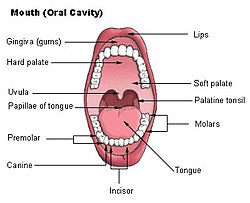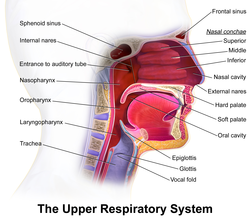Bony palate
| Hard palate | |
|---|---|

Mouth (oral cavity)
|
|

Upper respiratory system, with hard palate labeled at right.
|
|
| Details | |
| Artery | greater palatine artery |
| Nerve | greater palatine nerve, nasopalatine nerve |
| Identifiers | |
| Latin | palatum durum |
| MeSH | A02.835.232.781.324.502.660 |
| TA | A05.1.01.103 |
| FMA | 55023 |
|
Anatomical terminology
[]
|
|
The hard palate is a thin horizontal bony plate of the skull, located in the roof of the mouth. It is formed by the palatine process of the maxilla and horizontal plate of palatine bone, and spans the arch formed by the upper teeth.
The hard palate is formed by the palatine process of the maxilla and horizontal plate of palatine bone. It forms a partition between the nasal passages and the mouth. On the anterior portion of the roof of the hard palate are the plicae, irregular ridges in the mucous membrane that help facilitate the movement of food backwards towards the larynx. This partition is continued deeper into the mouth by a fleshy extension called the soft palate.
The hard palate is important for feeding and speech. Mammals with a defective hard palate may die shortly after birth due to inability to suckle (see Cleft palate below). It is also involved in mastication in many species. The interaction between the tongue and the hard palate is essential in the formation of certain speech sounds, notably palatal consonants such as /j/ and /ɟ/.
In the birth defect called cleft palate, the left and right portions of this plate are not joined, forming a gap between the mouth and nasal passage (a related defect affecting the face is cleft lip).
While cleft palate has a severe impact upon the ability to nurse and speak, it is now successfully treated through reconstructive surgical procedures at an early age, where such procedures are available.
...
Wikipedia
